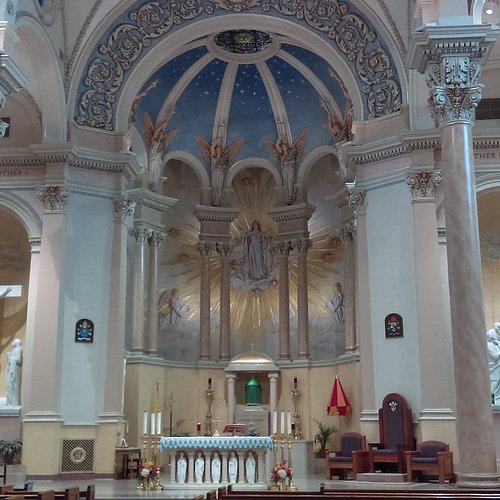Logan Ohio Churches: Explore Varied Worship Experiences in Your Area
Logan Ohio Churches: Explore Varied Worship Experiences in Your Area
Blog Article
Discovering Historical and Modern Churches for All Faiths
The exploration of modern-day and historical churches offers as an extensive lens whereby we can examine the advancement of confidence and area characteristics throughout societies. From the detailed layouts of old cathedrals to the minimalist appearances of contemporary prayer rooms, these structures envelop the significance of their time and place. They are not merely churches; they are reflections of cumulative ambitions and social worths. As we take into consideration the significance of these sacred sites, one must ponder how they remain to form interfaith dialogue and community engagement in today's varied globe.
Architectural Designs With the Ages
As architectural expressions of spirituality, churches have actually developed considerably over the centuries, reflecting the varied theological and social impacts of their times - Logan Ohio Churches. The building styles of churches are as differed as the idea systems they stand for, each design personifying particular religious teachings and community values
Very early Christian design emerged from Roman basilicas, defined by easy, longitudinal frameworks featuring a nave and aisles. As the Center Ages progressed, Gothic architecture took hold, marked by sharp arcs, ribbed safes, and flying buttresses, which enabled larger tarnished glass windows that illuminated insides with divine light. The Renaissance duration brought a revival of classical components, emphasizing percentage and symmetry, while Baroque design presented remarkable kinds and sophisticated information, symbolizing the splendour of spirituality.
In the 19th and 20th centuries, the increase of numerous movements, such as Arts and Crafts and Innovation, mirrored societal changes and a departure from typical forms. Today, contemporary churches often blend innovative layouts and contemporary products, welcoming sustainability and area involvement. This abundant tapestry of architectural designs shows the recurring dialogue in between confidence and style, showcasing exactly how churches continue to adjust to the spiritual needs of varied populations across the globe.
Famous Historic Churches

An additional remarkable example is the Notre-Dame Basilica in Paris, commemorated for its French Gothic design. Its elaborate façade and magnificent discolored glass home windows mirror centuries of dedication and virtuosity, making it a symbol of both faith and durability, particularly after its current restoration following the ravaging fire in 2019.
In the Americas, the historic Goal San Juan Capistrano in The golden state showcases Spanish colonial architecture, highlighting the early Catholic objectives that played a pivotal duty in the area's cultural advancement.

In Addition, the Hagia Sophia in Istanbul, originally built as a cathedral, stands for a blend of Christian and Islamic heritage, showcasing the abundant tapestry of history that churches typically personify. Each of these historic churches not only functions as a location of praise but additionally as a cultural site, maintaining the stories of diverse areas throughout time.
Modern Church Innovations
Modern churches are significantly welcoming ingenious styles and innovations to improve the worship experience and foster community engagement. These innovations manifest in various forms, from architectural advancements to electronic assimilation. Several modern churches feature open, flexible rooms that can be easily reconfigured to suit diverse activities, such as solutions, social celebrations, and curricula.
Incorporating technology is paramount in modern-day church style. Premium audio-visual systems, online streaming capabilities, and interactive displays permit churchgoers to link not only within their walls but additionally with a broader audience online. This digital outreach has actually become essential for keeping neighborhood connections, specifically in an age where numerous people look for spiritual connections past conventional setups.
Sustainable layout methods additionally play an important role in modern-day church advancements. Lots of institutions are going with environmentally friendly products and eco-friendly energy sources, mirroring a dedication to environmental stewardship that resonates with congregants.
Moreover, the integration of art and imagination into prayer spaces, with installments, murals, and multimedia discussions, offers to enhance the spiritual environment, making the experience extra immersive. These advancements jointly mirror a change in the direction of read the article an extra inclusive and dynamic strategy to worship and neighborhood life.
Neighborhood Influence of Churches
Churches play a vital duty fit and uplifting communities, frequently stepping up to deal with local needs and challenges. Past their spiritual features, these establishments regularly participate in social outreach and supply necessary solutions that cultivate area communication. Lots of churches run food financial institutions, shelters, and counseling solutions, addressing issues such as poverty, being homeless, and mental health.
Moreover, churches frequently act as event places for community occasions, assisting in dialogue and unity among varied groups. By hosting curricula, workshops, and social events, they encourage individual development and collective empowerment. Their engagement in local campaigning for initiatives intensifies the voices of marginalized areas, adding to social justice efforts.
Furthermore, churches often collaborate with regional organizations, improving their effect with partnerships that incorporate sources and expertise. This interconnectedness reinforces neighborhood ties and promotes a feeling of belonging amongst locals.
In essence, churches are not just churches; they are indispensable to the social material of their areas. Their complex payments-- spiritual assistance, social solutions, and neighborhood activism-- play an essential role in promoting durability and favorable modification within culture.
Seeing Churches All Over The World
When discovering the diverse landscapes of spirituality, visiting churches around the globe provides a distinct window right into the social and imaginative expressions of belief. Each church works as a testament to the history and worths of the community it stands for, mirroring building styles and neighborhood customs.
From the majesty of St - Logan Ohio Churches. Peter's Basilica in Vatican City to the minimalist charm of Tokyo's St. Mary's Basilica, these spiritual rooms personify a rich tapestry of human experience. The complex tarnished glass of Chartres Basilica in France tells scriptural tales, while the vibrant murals of the Ethiopian Orthodox churches portray the nation's unique spiritual heritage
In enhancement to showcasing artistic mastery, churches usually serve as facilities of community and social interaction, organizing occasions that strengthen bonds amongst congregants. Several also offer opportunities for interfaith discussion, advertising understanding and respect among various idea systems.
Taking a trip to these churches allows site visitors to appreciate the universal themes of hope, love, and concern that go beyond cultural obstacles. Whether one recognizes with a particular confidence or otherwise, the experience of going to these spiritual sites improves our understanding of the human quest for definition and link.
Conclusion

The expedition of modern-day and historical churches offers as an extensive lens through which we can analyze the evolution of confidence and area characteristics throughout cultures. Today, contemporary churches commonly blend ingenious styles and contemporary materials, embracing sustainability and community my review here engagement.Throughout history, countless churches have emerged as famous landmarks, each telling a distinct story of faith, virtuosity, and area.Modern churches are increasingly welcoming ingenious designs and modern technologies to improve the worship experience and foster area involvement.Furthermore, churches frequently serve as celebration locations for neighborhood events, helping with discussion and unity among diverse teams.
Report this page